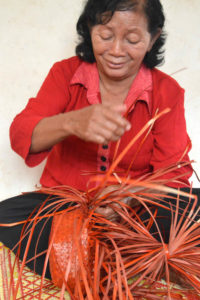
Basketry and plaiting are still practised by many of the 18 indigenous Orang Asli groups of Peninsular Malaysia, especially among subsistence farming communities. Items include back-carriers, sacks, winnowers and storage containers, as well as mats, betel boxes, kitchen baskets and fishing and hunting implements. All are woven from easily available natural fibers, though plastic twine and strapping are increasingly common substitutes.
Favoured natural fibers include wild harvested rattan canes (Calamus spp.), reeds (including Donax spp.) and jungle palms and the cultivated screwpine (Pandanus spp.), all split prior to use. The availability of these natural resources within each group’s ecological niche determines the type of basketry and plaiting produced.
There are two forms of basketry: coarse temporary baskets or mats woven for a single use or season, often for transporting fruits, forest produce, fish or game from the forest; and multi-season baskets woven more finely and from more durable material. Some Orang Asli groups also plait the wall panels of their traditional bamboo homes. Both men and women harvest and process raw materials, though mat plaiting is usually the domain of women.
Mats can also be classified into two types: large, coarse mats for agricultural use; and finer ones for ceremonial or ritual purposes, mostly woven from processed pandanus strips dyed with chemical dyes and patterned. The rarest, woven as a lattice (kerawang), are made by only a few weavers from two ethnic groups, the Jah Het (Pahang) and Semai (Perak and Pahang).
The rarest form of plaiting is known as anyam gila (lit. “mad weave”). It is a difficult hex-weave technique using pandanus strips, practised only by a handful of artisans from the Temuan, Mah Meri, Jah Het and Jakun groups. Items made include betel boxes, lidded containers and pouches.
Orang Asli basketry and plaiting are threatened by the loss of traditional territories and forests, which lessens the need for agrarian basketry. Deforestation reduces access to various natural fibres.
While there are collections of Orang Asli basketry and mats in museums in Peninsular Malaysia, including in the Aboriginal Craft Museum in Kuala Lumpur, little is available commercially. Insufficient demand, low production and limited market access have marginalised Orang Asli basketry and plaiting.






